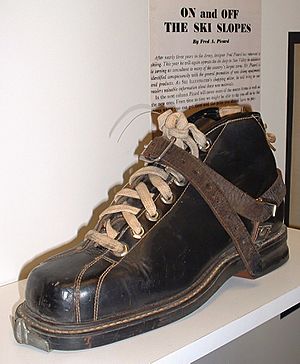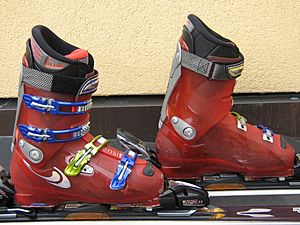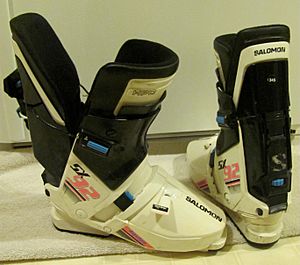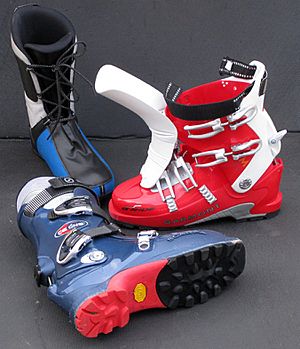Ski boot facts for kids
Ski boots are special footwear that connect a skier to their skis. They work with ski bindings to help the skier control the skis on the snow. This connection lets you steer and turn your skis easily.
Contents
History of Ski Boots
For a long time, ski boots were just regular leather winter boots. They were held onto the skis with leather straps. As skiing became more popular and specialized, ski boots also changed a lot. They started to be designed differently for alpine skiing (downhill skiing) and cross-country skiing.
Modern skiing began as a sport that included going uphill, downhill, and across flat areas. A new type of binding, called the cable binding, helped boots and bindings develop together. This binding wrapped a cable around the back of the boot to hold it firmly into a metal cup at the front. Boots were then made with special shapes at the heel for the cable to attach to.
For cross-country skiing, boots need to bend forward. This allows skiers to make a striding motion, like walking. So, cross-country boots were designed with a flexible sole. The top part of the boot, called the cuff, was soft for comfort and warmth. Modern cross-country ski boots are still very similar to those from the 1950s, but they now use new materials instead of leather.
When ski lifts were invented, skiers no longer had to walk uphill. This meant boots could be much stiffer, giving skiers better control when going downhill. A big step forward was the Kandahar cable binding in 1928. It held the heel firmly to the ski. This needed a stiffer boot sole, often with a wooden part inside. New boots were even treated with oil or glue to make them stiffer. These boots were often uncomfortable, especially when new. They also wore out quickly.
Alpine Ski Boots
Modern alpine ski boots have stiff bottoms and connect to the ski at both the toe and heel. This is done using a special binding that has springs. The way the boot and binding fit together is set by a standard called ISO 5355. Ski boots are measured using the Mondopoint system, which is a way to size footwear.
Front-Entry Boots
Front-entry boots are the most common type of downhill ski boot. Their design has changed over time from older leather boots.
In 1956, a Swiss company called Henke introduced boots with buckles instead of laces. Buckles made it easier to tighten the boot. To spread the pressure, these boots had C-shaped flaps that covered the opening where laces used to be. These flaps also helped keep snow out of the boot.
Around 1960, Bob Lange started trying to make boots from plastic instead of leather. In 1964, he combined a new, flexible plastic with the buckle system from Henke. This created the first modern plastic ski boot. When skier Nancy Greene started winning races with these boots in 1966, plastic boots became very popular. Plastic boots were much stiffer and gave better control. They were also more durable and warmer than leather boots, which often got wet and made feet cold. Over time, the part of the boot around the leg (the cuff) became taller, reaching about halfway to the knee by the 1980s. The basic design has not changed much since then.
Most modern front-entry boots have two main parts: one for the foot and one for the lower leg. These parts are connected by hinges near the ankle. This allows the leg to bend forward but not sideways. This design gives great control because even small movements of your leg are sent to the ski. However, the stiff cuff can make these boots hard to put on and take off. Also, because the boot squeezes the foot, it can be hard to find a perfect fit for everyone. Sometimes, the plastic shell of the boot needs to be heated and stretched to fit a skier's foot better. This is called "boot punching."
Rear-Entry Boots
Rear-entry boots were created in the early 1970s by the Hanson brothers. They wanted to make boots easier to put on and take off, and to fit better. These boots were very popular in the 1980s, especially designs from Salomon.
In a rear-entry boot, the whole foot area and bottom part are one piece, like a slipper. The leg cuff is split into a front and back part. The back part can swing far open, making it very easy to slide your foot in. When you close a cable, it pulls the back part forward, creating a stiff cuff that pivots at the ankle, just like a front-entry boot. Because the toe area is one piece and doesn't have buckles, rear-entry boots could sometimes feel a bit loose. Different systems were used to make them fit better. The good thing was that the foot area could be made larger, fitting almost any foot shape.
Rear-entry boots became less popular in the 1990s because racers preferred the tighter fit of front-entry boots. Today, front-entry boots are more comfortable and easier to get on and off, so rear-entry designs are less common, though some are still used as rental boots.
Three-Piece Boots
Three-piece boots were first developed around 1969. The main part of the boot was a single, strong shell. This made them easier to make. By 1972, plastic three-piece boots were available.
A boot designer named Sven Coomer improved the design with a special corrugated (wavy) tongue. This idea became popular with the Flexon boot in 1979. The Flexon was very popular with professional skiers, especially for moguls and freestyle. Today, several companies make three-piece boots, sometimes called "cabrio" boots. They are becoming popular again.
This design looks a lot like a front-entry boot, with separate foot and leg sections connected at the ankle. However, the front of the boot has an open slot. A separate plastic tongue is placed over this opening and buckled down to close it. This "open throat" design makes the boots easy to put on and take off. The shape of the tongue also allows for full control over how much the boot bends forward. One shell can be used with different tongues to get different stiffness levels, from very stiff for racing to softer for freestyle.
Nordic Ski Boots
Cross-Country and Telemark Boots
Cross-country boots, like all Nordic ski gear, usually attach to the ski only at the toe. This allows the boot to bend at the ball of the foot, similar to a normal shoe. Cross-country boots generally use one of four ways to attach to the ski: NNN (New Nordic Norm), 75mm Nordic Norm ("three-pin" binding), d-ring, or SNS (Salomon Nordic System). A newer Salomon Pilot binding is popular for racing because it has two connection points, giving skiers more stability. Since these boots are for traveling over mostly flat ground, they are light and efficient for movement.
Telemark is a special way to make downhill turns using Nordic equipment. This has led to very specific gear designed for better downhill performance. Until 1992, Telemark boots were mostly heavy leather boots that fit the 75mm Nordic Norm binding. The New Telemark Norm (NTN) binding, introduced in 2007, changed the technique a lot. Since then, plastic boots have become very common for Telemark skiing. Plastic allows the boot to be stiffer sideways while still letting the foot bend at the ball through special flexible parts called bellows. Boots for more cross-country travel are usually lighter, have a lower cuff, and are softer. Boots for downhill Telemark are heavier, have higher cuffs, and are stiffer. Telemark boots almost always have a rubber sole.
Alpine Touring Boots
Alpine touring, also called randonnée, is an alpine sport that combines cross-country striding for going uphill with regular alpine techniques for going downhill. The equipment is similar to modern Telemark systems. It uses a stiff plastic boot for good downhill control. The binding system allows the boot to pivot at the toe for cross-country striding. Different models offer a balance between being lightweight and performing well downhill. These boots have a curved, rubber sole that makes walking easier. This means they won't fit into regular alpine bindings. The way alpine touring boots and bindings connect is set by a standard called ISO 9523. Other ways to attach exist, like the Tech bindings, but these are not yet covered by an international standard.
Snowboarding Boots
Downhill sports like alpine skiing, Telemark, and snowboarding all involve turning by tilting the ski or board onto its edge. Once on its edge, the curved shape cut into the side (called the "sidecut") makes the ski or board bend into a curve. As they move over the snow, this curved shape causes them to turn.
Snowboard boots and bindings are usually much simpler than downhill ski boots. They rarely have release systems, for example. They mainly need to support the foot moving forward and backward. Snowboard bindings typically have an L-shaped outer frame that the snowboarder steps into. Straps then hold the boot securely in the frame. The boot itself doesn't have to transmit as much force, so it can be much softer than a typical downhill ski boot. When snowboarding first started, people used regular winter boots. But today, it's much more common to use semi-stiff snowboarding boots. Some special types of snowboarding use harder boots with step-in bindings, similar to ski bindings.
See also
 In Spanish: Bota de esquí para niños
In Spanish: Bota de esquí para niños
- Ski binding







